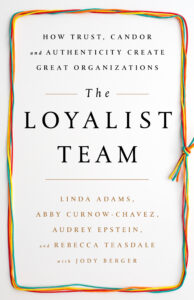The Magic of a Great Team
Great teams feel almost magical.
These rare teams build with care and intention. They operate at an incredibly high level of productivity and achieve extraordinary results.
Dysfunctional teams are unproductive, draining, and stressful. You’re always watching your back, focused on managing up, and fighting outside your silo.
Linda Adams, Abby Curnow-Chavez, Audrey Epstein, and Rebecca Teasdale honed their expertise inside some of the largest and most powerful businesses operating today. The four authors have led the human resources, talent management, leadership development, and organizational effectiveness functions of multiple Fortune 500 companies including Ford Motor Company, Pepsi, and Target. Currently, the four comprise the TriSpective Group, catering to companies like PetSmart, Kaiser, Orbitz, and others.
Their book, The Loyalist Team: How Trust, Candor and Authenticity Create Great Organizations, tackles the difficult subject of teams. Their work on creating high-performance teams has yielded expertise and results for all of us to learn from. I recently asked them to share some of their research.
What are some of the characteristics of a great team?
We studied thousands of teams in dozens of industries and found that the highest-performers had the same set of traits and characteristics. On these teams, individuals trust each other without reservation and assume positive intent, put the team agenda ahead of any personal agenda and hold each other accountable. We call them Loyalist Teams because they are loyal to one another, to the team, and to the organization as a whole.
You outline four different types of teams in this book. If you’re the new leader, how do you know your team’s persona?
A new leader can use one of our team assessments, including the Loyalist Team Snapshot that’s available for free on our website. We also suggest learning about the characteristics of Loyalist Teams and looking for them on the new team.
Leaders can ask themselves a series of questions including: Are there only pockets of trust on my team or do all team members trust one another? Do team members believe that “We only win together,” or are they more likely to think, “I look better if you lose”? How often and how well do team members put the real issues on the table and discuss them candidly and productively?
If trust is consistent across the team, individuals know their success is tied together, and they readily discuss even the tough issues, then the new leader is starting in a great place. If those elements are missing, we suggest the leader learn more about the less effective team types and determine actions to take to move the team along the spectrum to becoming a Loyalist Team.
Characteristics of a Toxic Team
On the other side of the equation are the toxic, dysfunctional teams. What characterizes them?
We call the least effective teams Saboteur Teams because on these teams, someone is always trying to sabotage someone else’s effort. Team members spend as much time watching their back as doing their own work. There’s a “Get them before they get me” mentality, and people often dread going into work. Bad behavior and poor performance go unchecked, and there is an overall sense that nothing will change.
What most contrasts a Saboteur Team with a Loyalist Team?
Loyalist Teams face winning and losing together. When the heat is on and the team is under pressure, Loyalist Teams find ways to come together and prevail. They learn from mistakes and losses, adjust and move on. Saboteur teams, already splintered, disintegrate into heated factions and waste time assigning and avoiding blame during the toughest times. While individual team members focus on self-preservation at all costs, the team’s performance spirals out of control.
When a Loyalist Team member leaves, how do you best ensure that the right person is hired and becomes part of the positive culture?
One thing we tell our clients as they are looking to add team members is to look beyond the experience the candidate brings to make sure that the person will be a cultural fit. Loyalist Teams have strong and clear operating norms that define how members will treat one another and work together. If you can, think about inviting other team members into the interview process so that they might have a stake in the chosen candidate’s success from the beginning. When interviewing potential team members, ask questions about teamwork successes and failures. Discuss your ideas about teamwork, collaboration and culture and let the potential hire know what will be expected of them so they can also consider if it will be the right fit.
What are a few ways Loyalist Teams trip up?
It takes hard work to maintain a Loyalist Team, and as you build success and strong, trusting relationships, it can seem really tough to provide critical feedback to colleagues for fear of damaging what has been hard won. And occasionally, teams feel they’ve “made it,” and they coast a bit. Maybe team members stop holding each other accountable as much, or they shy away from the tough conversations. Being a Loyalist Team is not a destination you permanently reach, but more a way of working together. There’s always more that can be done.
Create Loyalist Teams
Some leaders seem to create loyalist teams wherever they go. What is it about the leader that makes it possible to consistently build loyalist teams?
These leaders understand that they cannot build a Loyalist Team alone. Early on, they introduce the characteristics of the highest performing teams to their direct reports, and they gain team members’ commitment to begin the journey. Together, the team defines standards of performance and behavior, creates operating norms, and agrees to hold themselves and each other accountable. These leaders set the tone for the team, lead by example, and hold all team members accountable to Loyalist Team standards every day. And, they do not make exceptions, even for employees with needed technical expertise, high levels of production, or long-term experience. They know that everyone on their team must act as a Loyalist to create a Loyalist Team.
What are the benefits to having a Loyalist Team?
Because Loyalist Teams spend time discussing problems, debating solutions and collaborating effectively, they make decisions that stick. They don’t get caught in an endless loop of indecision. Loyalist Teams learn from their mistakes and take intelligent risks. They’re the teams that build new products, innovate industries and produce real value for their organizations. And the research shows that when compared to Saboteur Teams, Loyalist Teams are 2000 times more like to be viewed as highly effective by key stakeholders.
When we interview members of Loyalist Teams, they inevitably tell us they feel challenged and inspired by their teammates; they feel supported even when things don’t go exactly right, and they get to do their best work every day. In addition to the extraordinary performance that’s visible from the outside, Loyalist Team members always tell us that they’re very engaged with and passionate about their work and are having fun.
What are your hopes and expectations for those reading the book?
We wrote the book because we believe passionately that everyone deserves a great team, and we know from our work and our research that most teams are not great. Life is too short to be miserable at work, and we know that whether you are a team leader or a team member you have the ability to positively or negatively impact the team environment. Most people just don’t know where to start. Our book is for anyone who works on a team, leads a team or has responsibility for how effective teams are in their organization. In our book, we walk readers through diagnosing their team, knowing their team’s type, and identifying where to take action. Every team has the potential to be a great team, and we want that experience for everyone.
For more information, see The Loyalist Team: How Trust, Candor and Authenticity Create Great Organizations.


